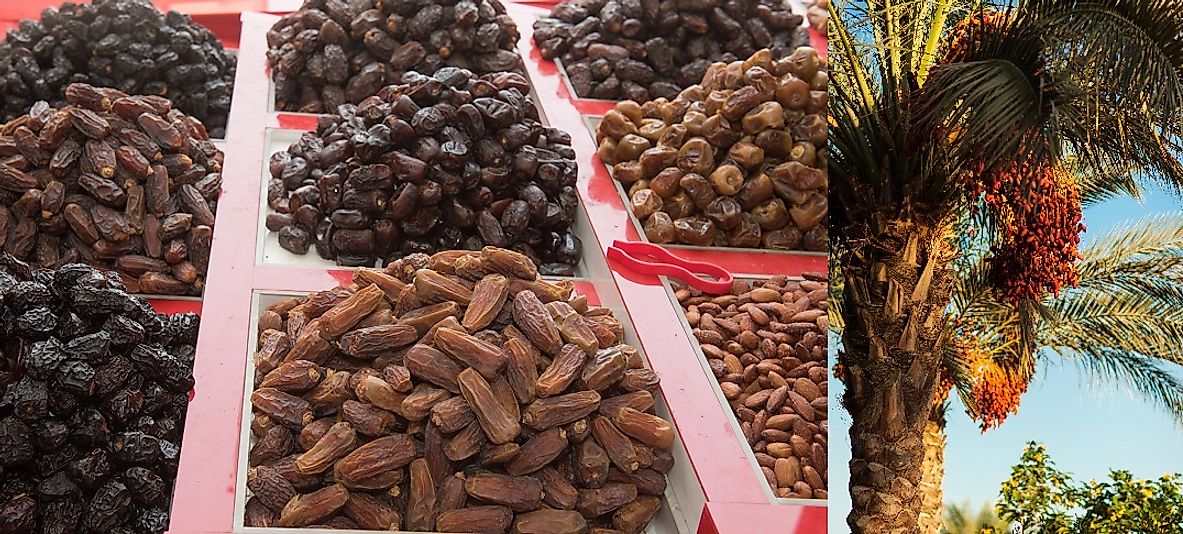Leading Countries Growing Dates (Fresh Date Palm Fruits)

Dates
Dates are oval-shaped, reddish-yellow, sweet fruits that grow on the date palm tree. Although not confirmed, it is believed that this tree originated in what is now present-day Iraq. Dates are considered a staple food throughout Middle Eastern countries with evidence of cultivation dating back as far as 7000 BC. As trade developed in this area with the rest of the world, dates were introduced to Southwest Asia, Northern Africa, and Spain. During the Spanish conquests in the Americas, dates were brought to Mexico, California, and later South America.
Cultivation
Date palms require arid and semi-arid conditions in places with long, hot summers and little to no rainfall for growth. In an agricultural setting, the roots are kept clear of grass and weeds that might hold in humidity and a small trench is dug around the base of the tree. This trench is filled with water so that it may go directly to the roots. When the fruit begins to form on long strands, agricultural workers remove the majority of the fruits to allow the remaining dates to grow to large sizes. These larger sizes are in high demand on the international market. Below is a look at which countries produce the greatest weight of dates every year and to where those dates are exported.
Leading Date Growing Countries
Egypt is the world leader in date production and cultivation. Each year, this country produces approximately 1,084,529 metric tons of dates. This represents a little over 17% of global date production but only 3% of world exports. Egypt has increased date cultivation by more than 100% since 1993 and currently has an estimated 15,582,000 date palm trees. Just over half, 53%, of exported Egyptian dates are imported by Morocco, this is followed by Indonesia (24%) and Malaysia (15%). The total export value is around $41.8 million.
Following Egypt, Iran produces 947,809 metric tons annually. Despite this large production rate, it only accounts for approximately 7.7% of total world exports. The majority of Iran’s date exports go to Asian countries. The biggest importers are India (16%) and Malaysia (11%). Russia follows by importing 9.9% of Iran’s exported dates.
The third largest producer of dates is Saudi Arabia. This country has the perfect conditions for date growth and cultivation, producing 836,983 metric tons per year. Nearly 388,000 acres across the country are dedicated to date palms and its fruit production. This country exports approximately 8.8% of the world’s dates which totals around $94.3 million. The primary importers of these exports are Jordan (19%), Yemen (17%), and Kuwait (15%).
Iraq produces 675,440 metric tons every year and is responsible for 7.3% of global date exports. This country once produced over 1 million metric tons annually and had 30 million date palms. That was in the 1980’s, however, before the war with Iran. Yearly production reached only 420,000 tons during Saddam Hussein’s regime. The government has since reinvested in the industry and is slowly increasing production. In 2014, the country exported $77.5 million worth of dates and 79% of that went to India. A significantly smaller percentage went to Egypt (8.5%) and Morocco (3.7%).
A list of these and other top date producing countries and their annual outputs of the fruit can be found below.
World Leading Countries Growing Fresh Dates
| Rank | Country | Annual Production of Fresh Dates in Metric Tons |
|---|---|---|
| 1 | Egypt | 1,084,529 |
| 2 | Iran | 947,809 |
| 3 | Saudi Arabia | 836,983 |
| 4 | Iraq | 675,440 |
| 5 | Pakistan | 556,608 |
| 6 | United Arab Emirates | 533,701 |
| 7 | Algeria | 485,415 |
| 8 | Sudan | 435,668 |
| 9 | South Sudan | 432,100 |
| 10 | Oman | 239,397 |











